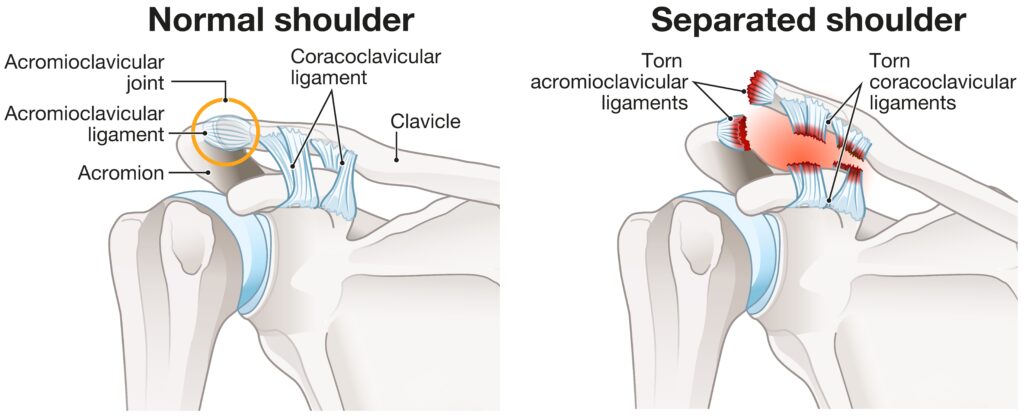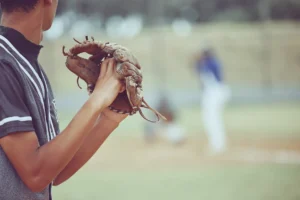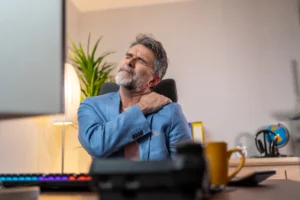The acromioclavicular, or AC joint, is the joint located at the top of the shoulder where the clavicle (collarbone) meets the scapula (shoulder blade). An AC joint separation, also known as a shoulder separation, is a common injury that occurs when the ligaments that stabilize the joint are either stretched or torn.

Causes
AC joint separations are almost always caused by an event where significant force was exerted on the area, such as in a fall or a direct blow. This type of injury is most commonly seen in contact sports such as football or hockey. Other activities that involve lifting heavy objects above the head, such as weightlifting also can cause injury to the joint. An AC separation involves damage to the ligaments that support the AC joint and is considered either a sprain or tear. These separations can range in severity from minor stretching of the ligaments to complete tearing of these ligaments. AC joint or shoulder separations are classified by the degree of torn ligaments involved:
- Grade I: This is the most common type of AC joint injury. TheAC ligament is stretched but the CC (coracoclavicular) ligaments are not injured. X-rays appear normal in this scenario.
- Grade II: The AC ligament is completely torn, while the CC ligaments are only partially torn. The collarbone appears slightly elevated on x-rays in this scenario.
- Grade III: The AC and CC ligaments are completely torn, and the clavicle and the acromion are completely separated. A bump is often visible on the shoulder where the clavicle is pushed up and is easily visible on x-rays.
- Grades IV –VI: Are uncommon and usually involve significant damage to the ligaments and soft tissues around the AC joint. These injuries almost always require surgical intervention.
Symptoms
The typical symptoms of an AC joint separation are severe pain at the top of the shoulder, including swelling and tenderness around the affected area. Limited movement may result from pain. Bruising may also be present. A more severe injury to the AC joint will result in a visible deformity or bump that is easily seen at the top of the shoulder and will likely be tender to touch or move.
Diagnosis and Treatment
Diagnosis is usually done through physical examination and X-rays to determine the extent of the injury and whether or not there has been any damage to the surrounding ligaments or tendons. A separation is often apparent from hearing how the injury occurred as well as the external appearance of the shoulder.
Treatment for an AC joint separation may involve a combination of rest, ice, compression, and elevation (RICE). This can help reduce inflammation and pain. If the injury is severe, surgical repair may be recommended to stabilize the joint and prevent further damage and to restore appropriate shoulder positioning and function. Following surgery, a rehabilitation program will help restore strength and range of motion in the shoulder.
In some cases, an AC joint separation can heal on its own with conservative treatments such as RICE. However, if the injury is severe or left untreated, it could lead to chronic instability of the joint and decreasedfunction of the shoulder. Therefore, it is important to seek medical attention as soon as possible following an injury.
Post-Operative Recovery
Post-operative recovery and therapy are essential for a successful outcome. Initially, this may involve gradual range of motion exercises combined with strengthening exercises to re-establish full function in the shoulder. Recovery time depends on the severity of the injury but typically takes several months. Fortunately, most AC joint injuries heal successfully with time and proper treatment.
The goal for the first few weeks is to reduce pain and shoulder joint stiffness. It is important to understand that while resting your shoulder is a necessary step for allowing an AC joint to heal, resting for any length of time may likely cause a gradual decrease in muscle strength and mobility. Therefore, during weeks 6-8, the goal will be to continue decreasing pain, increase muscular strength, and improve neuromuscular and proprioceptive control rehabilitation. Physical therapy will help you regain what you’ve lost during your recuperation period. The remaining weeks will involve transitioning to more home therapy and increased strengthening exercises. Exercises involving stretching and strengthening can play a critical role in fully restoring the health of your shoulder and upper arm.
Preventing AC Joint Separation
Preventing an AC joint separation altogether may be difficult to avoid however, it is possible to lower the risk in some instances. Strengthening exercises and proper stretching is especially important for athletes to lower the risk of AC joint separations. Strong, supple ligaments are far less likely to stretch or be injured than tight, stressed ligaments. Wearing proper fitting protective gear, including pads and braces during contact sports may reduce the risk of injury. It is also important to recognize exhaustion. An overtired and depleted body is far more susceptible to injury.
Knowing the signs and symptoms of AC joint separation, as well as how to prevent it can help you stay safe and avoid injury. If you suspect that you have an AC joint separation, seek medical attention from an orthopedic surgeon. The earlier a diagnosis and treatment plan is made; the more successful recuperation may be.
While AC joint separations are relatively common injuries, they can often be treated with conservative measures or surgery depending on severity. With proper treatment, healing without any long-term complications is likely. It is important to be aware of the signs and symptoms of an AC joint separation in order to seek care in a timely manner.
Please contact our office to schedule a consultation with Dr. McClintock.




